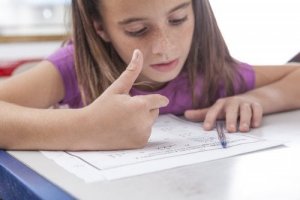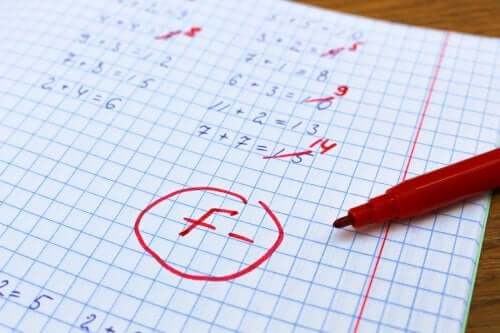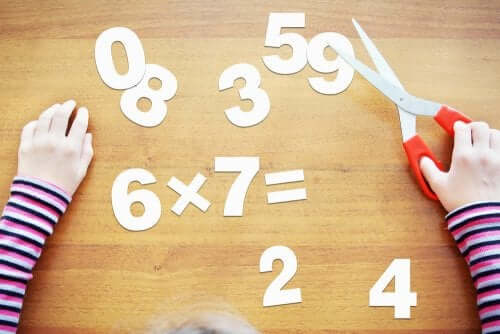Common Signs of Dyscalculia in Children


Written and verified by the psychologist Ana Couñago
It’s important for both parents and teachers to have a basic notion of this disorder in order to detect it. That’s why we want to share the following article to inform parents of the main signs of dyscalculia to look out for.
Children with dyscalculia make up part of a group of students with a specific need for educational support. Therefore, schools should offer them a series of specialized forms of support and attention.
This specific learning disorder affects a large number of children. Children with dyscalculia have a hard time acquiring mathematical competence, a basic skill when it comes to academic performance.
Acquiring mathematical competence
The acquisition of mathematical competence is something that takes place gradually. Therefore, over the course of their academic career, children slowly learn new concepts regarding:
- Numeration
- Seriation
- Calculation
- Mathematical problem-solving
- The carrying out of logical exercises
Furthermore, there is a wide variety of cognitive processes involved in learning mathematics. So, the thought processes that must develop in order to acquire mathematical competence are the following:
- Protonumerical knowledge
- Knowledge of numbers and counting
- Logical operations
- Knowledge of the numeric system
- Arithmetic operations
- Mathematical problem solving

We must keep in mind that, according to Gelman and Gallistel, the development of numeration and counting involves the assimilation of five principles:
- The first is learning the one-to-one association established between the counting of words and objects.
- The second consists of reciting counting words in a stable order (one…two… three… and so on).
- Number three has to do with cardinality. What is cardinality? Understanding that the last number mentioned when counting represents the quantity contained in a set as a whole.
- In fourth place is the principle of abstraction, which allows for the counting of any thing.
- Fifth is the irrelevance of order. This means being able to count by means of any sequences, without the result being altered.
Signs of dyscalculia in children
Dyscalculia is a specific type of learning disability. It affects a person’s ability to acquire knowledge regarding math and calculations.
This difficulty doesn’t imply the presence of reduced intellectual ability. Nor is it the result of academic deprivation or poor learning methods. In other words, when a child makes frequent mistakes with numerical data, it can be one of the possible signs of dyscalculia.
Therefore, the symptoms you may observe in a child with dyscalculia are the following:
- Frequently resorting to finger counting in order to solve simple operations
- Difficulty in understanding the meaning of numbers
- Having a hard time interpreting quantities
- Difficulties when writing and reading numbers
- Having problems memorizing/automatizing multiplication tables
Of course, it’s important that when observing these red flags, you also keep in mind:
- The child’s chronological age
- The child’s development level
So, what should you do if you suspect a child may have a case of dyscalculia? First, get in touch with his or her school. That way, you can discuss your concerns with the teaching staff. The school’s orientation department can also conduct a thorough evaluation of the case.
There are a variety of tests that professionals can use to diagnose dyscalculia in students. These tests evaluate a child’s computation skills, math skills, and mental computation.

Helping children with dyscalculia
In order to help children with dyscalculia at home, you need to make things playful and fun. Avoid pressuring children or producing stress. Below are some ideas for improving mathematical competence at home:
- Practice hobbies and daily tasks that involve numbers
- Teach calculation through demonstration and modeling
- Play games that require the need to perform arithmetic
- Carry out practical calculation exercises. In other words, apply math in daily life.
Furthermore, make sure that your child’s school takes the necessary measures to meet his or her individual learning needs. Most often, these students will attend individual sessions with a therapeutic pedagogy teacher.
This way, you and the school can help your child with specialized materials, focusing on reinforcing the acquisition of math skills.
It’s important for both parents and teachers to have a basic notion of this disorder in order to detect it. That’s why we want to share the following article to inform parents of the main signs of dyscalculia to look out for.
Children with dyscalculia make up part of a group of students with a specific need for educational support. Therefore, schools should offer them a series of specialized forms of support and attention.
This specific learning disorder affects a large number of children. Children with dyscalculia have a hard time acquiring mathematical competence, a basic skill when it comes to academic performance.
Acquiring mathematical competence
The acquisition of mathematical competence is something that takes place gradually. Therefore, over the course of their academic career, children slowly learn new concepts regarding:
- Numeration
- Seriation
- Calculation
- Mathematical problem-solving
- The carrying out of logical exercises
Furthermore, there is a wide variety of cognitive processes involved in learning mathematics. So, the thought processes that must develop in order to acquire mathematical competence are the following:
- Protonumerical knowledge
- Knowledge of numbers and counting
- Logical operations
- Knowledge of the numeric system
- Arithmetic operations
- Mathematical problem solving

We must keep in mind that, according to Gelman and Gallistel, the development of numeration and counting involves the assimilation of five principles:
- The first is learning the one-to-one association established between the counting of words and objects.
- The second consists of reciting counting words in a stable order (one…two… three… and so on).
- Number three has to do with cardinality. What is cardinality? Understanding that the last number mentioned when counting represents the quantity contained in a set as a whole.
- In fourth place is the principle of abstraction, which allows for the counting of any thing.
- Fifth is the irrelevance of order. This means being able to count by means of any sequences, without the result being altered.
Signs of dyscalculia in children
Dyscalculia is a specific type of learning disability. It affects a person’s ability to acquire knowledge regarding math and calculations.
This difficulty doesn’t imply the presence of reduced intellectual ability. Nor is it the result of academic deprivation or poor learning methods. In other words, when a child makes frequent mistakes with numerical data, it can be one of the possible signs of dyscalculia.
Therefore, the symptoms you may observe in a child with dyscalculia are the following:
- Frequently resorting to finger counting in order to solve simple operations
- Difficulty in understanding the meaning of numbers
- Having a hard time interpreting quantities
- Difficulties when writing and reading numbers
- Having problems memorizing/automatizing multiplication tables
Of course, it’s important that when observing these red flags, you also keep in mind:
- The child’s chronological age
- The child’s development level
So, what should you do if you suspect a child may have a case of dyscalculia? First, get in touch with his or her school. That way, you can discuss your concerns with the teaching staff. The school’s orientation department can also conduct a thorough evaluation of the case.
There are a variety of tests that professionals can use to diagnose dyscalculia in students. These tests evaluate a child’s computation skills, math skills, and mental computation.

Helping children with dyscalculia
In order to help children with dyscalculia at home, you need to make things playful and fun. Avoid pressuring children or producing stress. Below are some ideas for improving mathematical competence at home:
- Practice hobbies and daily tasks that involve numbers
- Teach calculation through demonstration and modeling
- Play games that require the need to perform arithmetic
- Carry out practical calculation exercises. In other words, apply math in daily life.
Furthermore, make sure that your child’s school takes the necessary measures to meet his or her individual learning needs. Most often, these students will attend individual sessions with a therapeutic pedagogy teacher.
This way, you and the school can help your child with specialized materials, focusing on reinforcing the acquisition of math skills.
All cited sources were thoroughly reviewed by our team to ensure their quality, reliability, currency, and validity. The bibliography of this article was considered reliable and of academic or scientific accuracy.
- García-Orza, J. (2012). Dislexia y discalculia.¿ Extraños compañeros de viaje? Conferencia para el XXVIII Congreso de Aelfa. Revista de Logopedia, Foniatría y Audiología, pp. 142-151.
- Mastropieri, M. A., Scruggs, T. E. y Shiah, S. (1991). Mathematics instruction for learning disabled students: A review of research. Learning Disabilities Research and Practice, 9, 49-58.
- Miller, S. P. y Mercer, C. D. (1997). Educational aspects of mathematics disabilities. Journal of learning disabilities, 30(1), 47-56.
- Miranda, A., Fortes, F. y Gil, M.D. (2000). Dificultades del aprendizaje de las matemáticas: un enfoque evolutivo. Málaga: Ediciones Aljibe.
This text is provided for informational purposes only and does not replace consultation with a professional. If in doubt, consult your specialist.








